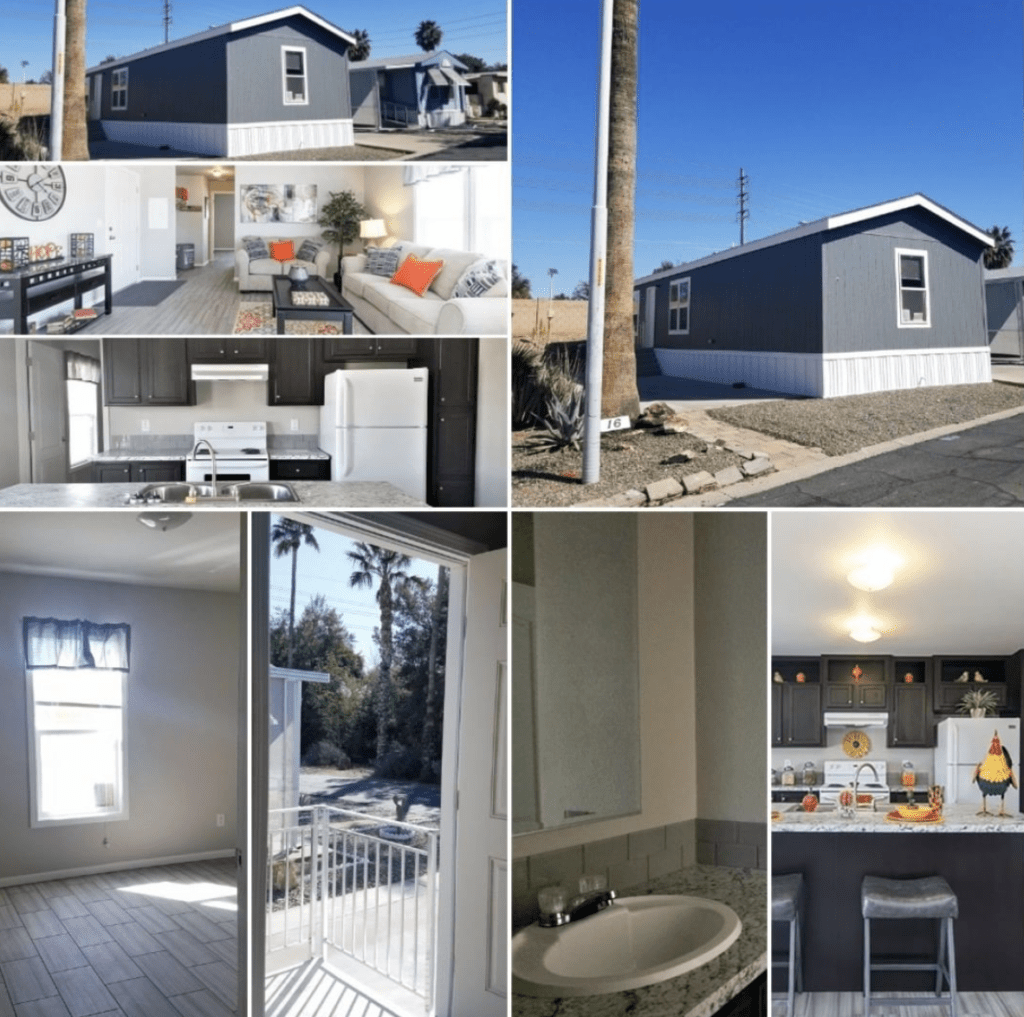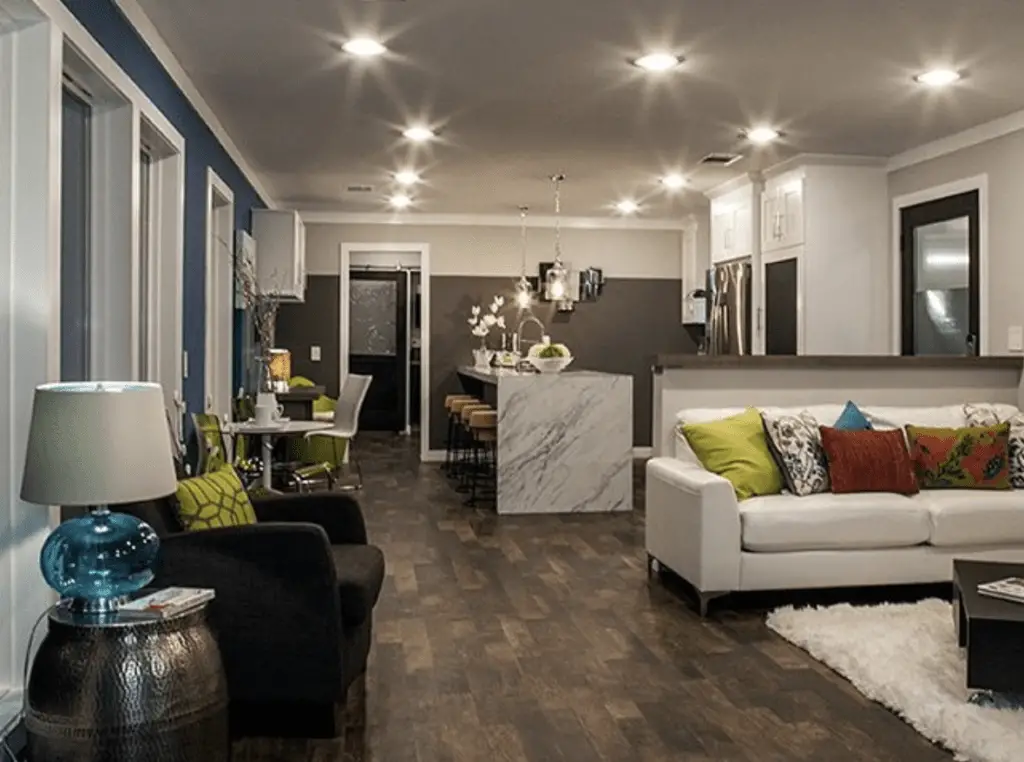Manufactured homes have come a long way since the 1960s in both design and quality. It is easy to find a manufactured home that fits every need and budget. Models range from the bare basics to top-of-the-line luxury design.
We’ve shared a ton of great articles about buying mobile and manufactured homes. In this article, we asked a manufactured home dealer to list a few things they thought a potential manufactured home buyer should know. These 5 Things to Know Before Visiting a Manufactured Home Dealer were written with their help.
Choosing the Right Size is More Difficult than Most Realize
It is important to know what the lot size for the home is to determine which configuration will fit right. Too big of a home on too small of a lot can look unnatural. Decide on the home that fits your family’s lifestyle best.
Working Space
A lot of families go wrong by buying a large home but it doesn’t fit their lifestyles. A smaller home can actually work better if it has the right kind of working space. Do you all like to watch TV together after dinner? A large family room with a central TV spot would work great. Budding chefs would love a large kitchen with a center island. Wanna-be makeup artists would thrive in a large master bedroom suite.
Dead Space
Don’t buy a home that is too large and end up with dead space that is expensive to heat and cool. If a room is not used in a home several issues can happen: leaks occur without notice and condensation and moisture is hard to control in a room that isn’t used since there is little to no air circulation. A 3 bedroom home is great but if it’s only needed for 2 years is it worth heating and cooling for decades?
Most manufactured homes come in three widths:
Single Wides
Modern single wides can range from 66 feet to 80 feet.
They are available in widths of 14, 16 and 18 feet.
They can have anywhere between 800 square feet of living space to 1500.
Double Wides
Double wides range from 42’ to 60’ feet long.
Common widths range from 20-feet to 36-feet.
They typically have 1,067 square feet to over 2,300.
The most common double wide sizes are 24’, 28’ and 32’ wide and the areas range from 1,067 SF to 2,300 square feet. As such, these homes have a larger footprint and feel more spacious.
Triple Wides are 3 separate units that can feature varying asymmetrical floor plans and look most like a site-built home. They are a dream home for larger families and can be configured to have over 4,000 square feet. These are not very common to find on the East coast but they are gaining popularity on the west coast.
A carport, deck, patio and sometimes even an enclosed garage can be added to the home and that should be decided before the home is ordered. You can save money by not finishing a perimeter wall that will be shared with a garage or sunroom.

Budgeting Transport and Setup Costs Correctly
Another popular mistake that newbie manufactured home buyers make is miscalculating transport, installation, and setup.
As a rule of thumb, the more the units, the higher the transportation, the setup and overall cost of the home. There are a lot of things that need to be done to set up a manufactured home, especially on a newly cleared private lot. There’s power, water, sewer, and gas to start. Grading is needed on every home to ensure the is a 10″ downward grade for the first 6″ past the home’s perimeter.
Location and terrain are big factors in manufactured home transport prices though distance and site prep are also important. Be sure to talk to at least 3 transport teams in your area to get an estimate. You may be better off just letting the dealership handle everything for you if you aren’t knowledgeable of the installation process. However, if you can handle everything yourself and in the right order, it usually pays to act as your own contractor.
Choosing the Best Features and Amenities for Your Family
It is important to determine how much home you can afford. Monthly payments for the home, after accounting for the added cost of insurance, taxes, and maintenance should be 25% to 28% of total monthly income after taxes according to many financial experts.
The base model double wide could cost less than an upgraded single wide.
Features
Knowing what features are important to you and your family before searching for a new manufactured home will help keep within budget.
A few features to consider:
- · Number of Bedrooms
- · Number of Bathrooms
- · Do You Need a Separate Family Room?
- · Is a Patio or Deck Something You’d Use?
- · How Important is a Carport or Garage?
- · Are Energy Efficiency Features Important?
- · What’s the Minimum Ceiling height that I Need?
- · Do We Need a Storage Shed?
- · Are Walk-in Closets and Pantries Important?

Upgrades
Certain upgrades are necessary and help increase the life of the home and enhance the home’s value. However, there are other upgrades that can be done later for a lot less money.
Upgrades that provide best value include:
- · 30 Year Architectural Shingles
- · Insulation (highest rating)
- · Pitched roof (4/12 or more)
- · 2×6 Exterior Framing on 16″ centers
- · 2×4 Interior Wall Studs
- · Exterior sheathing
- · Vinyl siding
- · Shutoff valves at all water sources
- · Real wood flooring, as opposed to particleboard
- · Exterior and Interior Doors
- · Windows
- · Sheetrocked Walls
- · Solid wood Cabinetry
- · Higher end Sinks, Showers, Tubs (faucets can wait)
Read more about the best upgrades to get when buying a new manufactured home here.
Price Negotiations
Don’t be scared to negotiate. Maybe even read an article or two about the art of negotiating. Dealerships typically have 18% to 25% markups on each home and even at invoice price they can make a profit similar to auto dealerships based on manufacturer rebates. So don’t be scared to negotiate the price.
Total Price
Dealers may try to steer the conversation to monthly payments as opposed to the total price. You want to negotiate on the total price. Learn more about buying a manufactured home at these articles:

Financing and Taxes
When manufactured homes are located in a park or leased land, they are classified as personal property. Several lenders specialize in financing these homes. The terms and rates are based on the age, condition, and type of home.
Manufactured homes that are (or will be) permanently affixed to land are classified as real property and qualify for Fannie Mae, Freddie Mac, FHA, VA and USDA loans. The real property classification means higher taxes but it also means that the home is likely to appreciate more. In most rural areas over 2/3rds of manufactured homes are set up on land owned by the homeowner but they aren’t reclassified as real property. They remain personal property, mostly for the lower taxes. These homes do not appreciate as well as manufactured homes classified as real property.
Few real estate lenders will finance mobile homes built prior to 1976. Chattel and personal loans are used instead. Read about the top three manufactured home financing options here.
Summary – 5 Things to Know Before Visiting a Manufactured Home Dealer
Manufactured homes are built to strict standards and cost 20% to 50% less than site-built homes. Understanding what you need in a house and learning the art of negotiation would be smart moves before you walk onto a manufactured home dealer’s lot. Knowing what to expect when you go to a dealership will help with making the best buying decision.
Thank you for reading Mobile Home Living®!
Big thank you to 365RealtyDeals for answering our questions truthfully. Much appreciation for that. You can find them on Facebook and Instagram.
Image Source: 365RealtyDeals and mh_factory_direct.

Great information!! Thank you for providing it here. Love all of the articles on Mobile Home Living!
We are searching for 1950 to 1970 style mobile homes in SC. Do you have any search ideas for locating these vintage beauties?
Thank you!
Thank you for sharing this information – there are “pro’s & con’s” for every decision that must be made in the process of obtaining manufactured home ownership. Your articles very much help those of us, who have never done it, steer clear of the errors. Greg